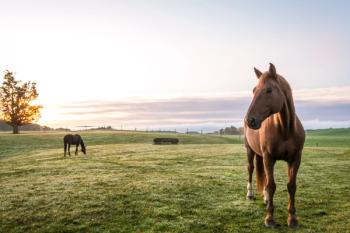
UC Davis equine veterinarians warn of Pistacia poisonings
Leaves and seeds of pistachio-related genus can cause hemolytic anemia, death in horses.
UC Davis research has discovered that Pistacia trees can be toxic to horses if ingested. Photos courtesy of UC Davis.As autumn nears, University of California, Davis, veterinarians are warning general practitioners and horse owners to keep animals away from Pistacia orchards, as the leaves and seeds of this genus can cause hemolytic anemia and be fatal if ingested.
In the fall of 2013, after the acute deaths of five mares from a large herd, two surviving mares were brought to the UC Davis veterinary hospital after two days of lethargy and icterus. The deceased horses had varying degrees of colic, ataxia, pigmenturia, pale and icteric mucous membranes, lethargy and inappetance. All died within 48 hours of initial signs, according to a UC Davis release.
Dr. Rana BozorgmaneshWhile UC Davis' Equine Medicine Service worked to save the two mares, one of the veterinarians on the case, resident Rana Bozorgmanesh, BVSc, started researching the cause of the deaths. She and the service team, along with members of the toxicology department, discovered that the sick horses had access to a planted Pistacia orchard (containing the species P. atlantica, P. terebinthus and P. chinensis) after the fall harvest. (The most common species of the Pistacia genus is, of course, P. vera, or the pistachio nut.)
There were no recent changes in herd management or housing, except for the felling of the Pistacia orchard shortly before the first horse developed clinical signs; the owner had witnessed the horses eating from trees that had been cut down. Other horses on the property that were not allowed access to the orchard did not exhibit any signs of illness.
A site visit by Bozorgmanesh, along with veterinary students and staff, was performed to inspect the property for possible toxin exposure. Sampling of the water, hay, trees and vegetation was conducted to investigate potential intoxication as the cause of hemolytic anemia, usually associated with an oxidant toxin such as maple trees, onions or other plants associated with oxidant damage or hemolysis in horses. None of these were found on the property.
The owner was instructed to move the herd away from access to Pistacia trees and to administer activated charcoal to horses observed to ingest Pistacia leaves or seeds. Upon moving the mares to a smaller area of the property with no access to Pistacia trees, there were no additional illnesses or deaths.
Pistacia trees are not native to North America but are found in California as well as several other states ranging from the Southwest to the Southeast of the United States, where fertile land produces much of the world's marketable Pistacia products, the UC Davis release states. The California outbreak arose in the fall, the same seasonality as reported with red maple leaf toxicosis, when the leaves are wilted and falling off the trees. A similar incident with Pistacia has occurred in Arizona, also during a time when leaves were falling off the tree.
“While the horses had access to the trees throughout the remainder of the year, we propose the problem lies with the felled and wilted leaves,” says Bozorgmanesh, who ultimately became the lead author on a piece of groundbreaking clinical research.1 “The felled trees in the California outbreak would have allowed for easy access and ingestion of large quantities of wilting leaves and seeds by the horses, thus accentuating these effects.”
In vitro studies by UC Davis toxicologists showed extracts of the seeds and leaves induced lysis of horse red blood cells in the laboratory setting. Further research is required to identify the exact pathophysiology of Pistacia tree toxicosis, the toxic principles involved and the quantities required to cause clinical disease in horses.
“Until that time, it is clear that horses must be isolated from these trees to prevent acute hemolytic anemia and death,” adds Bozorgmanesh.
Reference
1. Bozorgmanesh R, Magdesian KG, Rhodes DM, et al. Hemolytic anemia in horses associated with ingestion of Pistacia leaves. Jour Vet Internal Med 2015;9:410-413.
Newsletter
From exam room tips to practice management insights, get trusted veterinary news delivered straight to your inbox—subscribe to dvm360.






